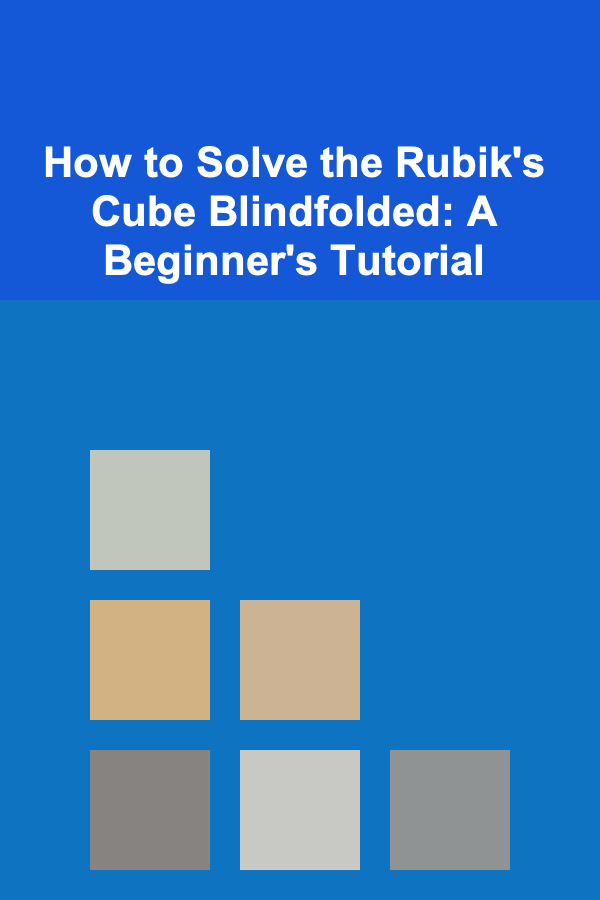
How to Solve the Rubik's Cube Blindfolded: A Beginner's Tutorial
ebook include PDF & Audio bundle (Micro Guide)
$12.99$10.99
Limited Time Offer! Order within the next:

The Rubik's Cube is one of the most iconic puzzles in the world. It has challenged and intrigued puzzle enthusiasts for decades, with its combination of simplicity and complexity. For many, solving the Rubik's Cube is already an impressive feat. But for some, the challenge doesn't stop there --- they take it a step further and solve the Rubik's Cube blindfolded.
Solving the Rubik's Cube blindfolded is a skill that requires both mental agility and memory. It's a combination of spatial awareness, pattern recognition, and memorization. While it may sound intimidating, with the right techniques and practice, anyone can learn how to solve a Rubik's Cube blindfolded.
In this tutorial, we'll walk you through the essential steps of solving a Rubik's Cube blindfolded, from understanding the method to mastering the required techniques. This guide is designed for beginners, so you don't need to be an expert cuber to start. With dedication and focus, you'll be solving the cube blindfolded in no time.
Understanding the Basics of the Rubik's Cube
Before you can attempt solving the Rubik's Cube blindfolded, you need to be familiar with the basics of the puzzle itself. The Rubik's Cube consists of 26 smaller pieces: 8 corner pieces, 12 edge pieces, and 6 fixed center pieces. Each face of the cube is made up of 9 squares, and the goal is to align all the squares on each face to a single color.
The Rubik's Cube operates on a system of moves, where each face of the cube can be rotated 90 degrees, 180 degrees, or 270 degrees in either direction. These moves are represented by specific notations, which we will cover in the next section.
To solve the Rubik's Cube blindfolded, you must first be able to solve it with your eyes open. If you are not yet familiar with the standard method of solving the Rubik's Cube (often referred to as CFOP), it's essential to learn this first. Blindfolded solving builds on these basic techniques and requires an additional layer of skill.
The Blindfolded Solving Method: A Step-by-Step Guide
The most popular method for solving the Rubik's Cube blindfolded is called the Old Pochmann Method. This method is widely used by blindfolded cubers because it's relatively easy to learn, even for beginners.
Here are the key steps involved in solving the Rubik's Cube blindfolded using the Old Pochmann Method:
Step 1: Memorizing the Cube
The first step in solving the Rubik's Cube blindfolded is memorizing the positions of the pieces. Since you won't be able to see the cube while solving it, you need to create a mental map of the cube's layout. This is done by assigning numbers or letters to the pieces and memorizing their positions relative to each other.
To do this, you'll need to use a method called letter pairs or number-letter pairs. The Rubik's Cube's corner and edge pieces are labeled, and you will memorize which pieces need to be moved during the solve.
Memorizing the Corners:
There are 8 corner pieces on the Rubik's Cube, and each can be designated by a specific position (e.g., front-top-left, back-bottom-right). In the Old Pochmann method, you memorize the orientation and placement of the corner pieces before solving them.
Memorizing the Edges:
Similarly, the Rubik's Cube has 12 edge pieces. You can memorize the positions of these edge pieces by assigning each one a number or letter, and then linking these pieces with a mental association or a memorization system, such as a number-letter association.
The key to memorizing the pieces efficiently is repetition. Practice observing the cube, assigning labels, and creating associations until you can visualize the cube in your mind.
Step 2: Starting the Solve -- Edge and Corner Cycles
Once you've memorized the cube, you can begin solving it using two distinct cycles: the corner cycle and the edge cycle. These two cycles are what you will perform while blindfolded.
Solving the Corners:
To start the solve, you'll need to focus on solving the corner pieces first. The Old Pochmann method uses a technique called the corner-solving algorithm, which will cycle the corner pieces into the correct positions one by one.
You will perform a series of moves that switch the corner pieces without disrupting the already solved pieces. These moves will be executed based on your mental map of the cube.
Solving the Edges:
After solving the corners, you will move on to solving the edge pieces. The edge-solving algorithm is similar to the corner-solving algorithm but specifically designed for the edges. In the Old Pochmann method, the edges are solved using a sequence of moves that swap the edge pieces while maintaining the cube's structure.
Step 3: Applying the Algorithms
Both the corner cycle and the edge cycle involve performing specific algorithms that swap and rotate the pieces into the correct positions. These algorithms are the key to solving the cube blindfolded.
Here are the two basic algorithms used for blindfolded solving in the Old Pochmann method:
Corner Algorithm:
- R U' R' U' R U2 R' (This algorithm cycles three corner pieces and can be repeated multiple times to place all the corners in their correct positions.)
Edge Algorithm:
- R U' R' U' R U2 R' (This algorithm swaps two edges and can also be repeated as needed to solve all the edges.)
Step 4: Practicing and Memorizing the Algorithms
The most challenging part of solving the Rubik's Cube blindfolded is memorizing the algorithms and executing them accurately. To help you memorize the algorithms, practice repeatedly. Break the cube down into smaller sections and solve each one step-by-step until you can solve the entire cube.
As you practice, you'll become more comfortable with visualizing the cube and executing the necessary moves without looking at it. Over time, you'll improve your speed and accuracy, allowing you to solve the Rubik's Cube blindfolded with ease.
Step 5: Training Your Memory
An essential aspect of blindfolded cubing is improving your memory. The key is to train your brain to recognize patterns and associations quickly. One technique is to visualize the cube in your mind and recall the positions of the pieces while memorizing the move sequences.
You can also practice memory techniques like the method of loci or memory palaces, which involve creating vivid mental images to remember the positions of pieces. This will make it easier to visualize the cube and execute the moves while blindfolded.
Tips for Mastering Blindfolded Solving
- Start Slow: Initially, practice with your eyes open and slowly work your way to solving the cube with a blindfold. This gradual progression will help you build confidence and muscle memory.
- Use a Simple Memorization System: When memorizing the cube, keep your memorization system simple and easy to recall. Don't try to overcomplicate the process.
- Practice Algorithms: The more you practice the algorithms, the more comfortable you'll become with executing them efficiently and without hesitation.
- Stay Calm: Solving the Rubik's Cube blindfolded can be a nerve-wracking experience. Stay calm and focus on executing each step methodically. Over time, it will become second nature.
- Record Your Times: Track your progress and set personal goals. This will help you stay motivated and give you something to measure your improvement against.
Conclusion
Solving the Rubik's Cube blindfolded is an impressive skill that requires practice, memorization, and patience. By using the Old Pochmann method, breaking down the process into smaller cycles, and training your memory, you can learn to solve the Rubik's Cube without looking at it. With time, you'll be able to solve the cube faster and more efficiently, impressing your friends and expanding your cubing skills.
Remember, the key to success is practice, so don't get discouraged if you don't get it right immediately. Keep practicing, and soon you'll be solving the Rubik's Cube blindfolded like a pro.
Reading More From Our Other Websites
- [Home Rental Property 101] How to Set the Right Rent Price for Your Property in a Competitive Market
- [Personal Financial Planning 101] How to Make Your Money Work for You Through Passive Income
- [Home Budget 101] How to Create a Weekly Budget That Fits Your Lifestyle
- [Home Renovating 101] How to Plan for Proper Ventilation in Your Home Renovation
- [Biking 101] Cycling Training for Performance: How to Push Your Limits
- [Home Holiday Decoration 101] How to Create a Stunning Holiday Centerpiece for Your Dining Table
- [Organization Tip 101] How to Use Labels for Easy Identification of Items
- [Personal Investment 101] How to Invest in the Stock Market: A Beginner's Roadmap
- [Home Budget Decorating 101] How to Decorate Your Home with Affordable Wall Mirrors
- [Personal Investment 101] How to Make Your First Real Estate Investment with Little Money

How to Choose the Right Argos Floor Lamps for Your Living Space
Read More
How to Integrate Company Culture into Employee Onboarding
Read More
How to Make Your Home Feel Warm and Inviting During the Holidays
Read More
How to Use Shadow Boxes to Showcase Vintage Memorabilia
Read More
Rekindling Romance: Keeping the Spark Alive
Read More
10 Essential Items: A Painting Prep Checklist
Read MoreOther Products

How to Choose the Right Argos Floor Lamps for Your Living Space
Read More
How to Integrate Company Culture into Employee Onboarding
Read More
How to Make Your Home Feel Warm and Inviting During the Holidays
Read More
How to Use Shadow Boxes to Showcase Vintage Memorabilia
Read More
Rekindling Romance: Keeping the Spark Alive
Read More